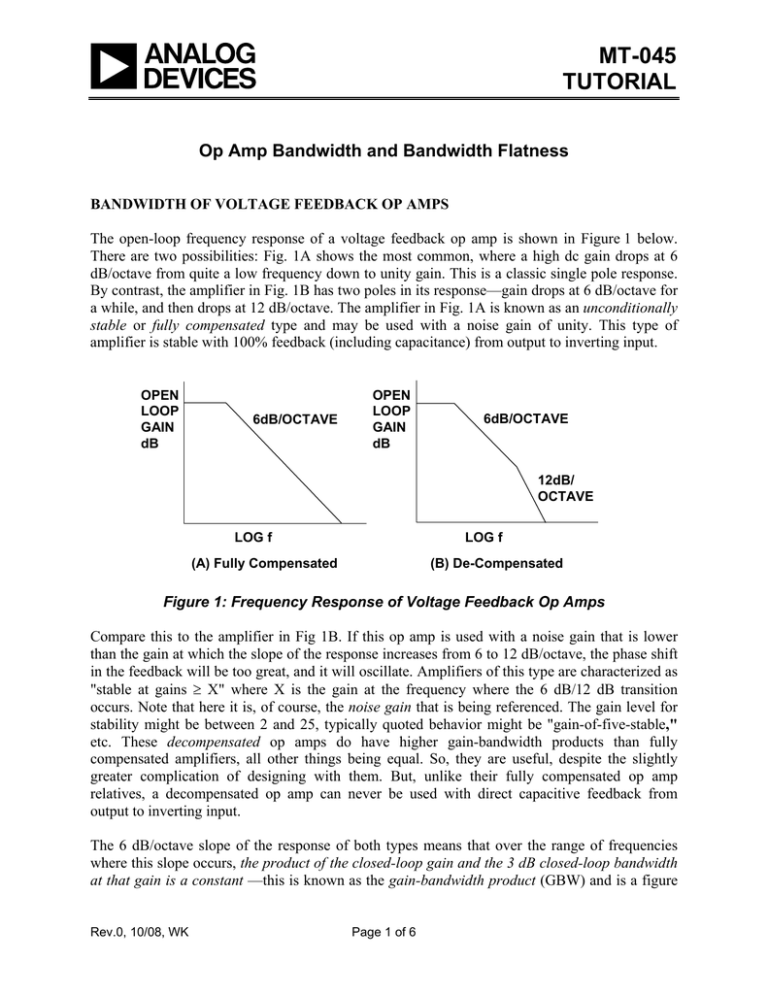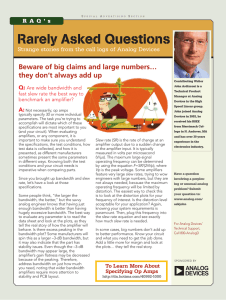
MT-045
TUTORIAL
Op Amp Bandwidth and Bandwidth Flatness
BANDWIDTH OF VOLTAGE FEEDBACK OP AMPS
The open-loop frequency response of a voltage feedback op amp is shown in Figure 1 below.
There are two possibilities: Fig. 1A shows the most common, where a high dc gain drops at 6
dB/octave from quite a low frequency down to unity gain. This is a classic single pole response.
By contrast, the amplifier in Fig. 1B has two poles in its response—gain drops at 6 dB/octave for
a while, and then drops at 12 dB/octave. The amplifier in Fig. 1A is known as an unconditionally
stable or fully compensated type and may be used with a noise gain of unity. This type of
amplifier is stable with 100% feedback (including capacitance) from output to inverting input.
OPEN
LOOP
GAIN
dB
6dB/OCTAVE
OPEN
LOOP
GAIN
dB
6dB/OCTAVE
12dB/
OCTAVE
LOG f
LOG f
(A) Fully Compensated
(B) De-Compensated
Figure 1: Frequency Response of Voltage Feedback Op Amps
Compare this to the amplifier in Fig 1B. If this op amp is used with a noise gain that is lower
than the gain at which the slope of the response increases from 6 to 12 dB/octave, the phase shift
in the feedback will be too great, and it will oscillate. Amplifiers of this type are characterized as
"stable at gains ≥ X" where X is the gain at the frequency where the 6 dB/12 dB transition
occurs. Note that here it is, of course, the noise gain that is being referenced. The gain level for
stability might be between 2 and 25, typically quoted behavior might be "gain-of-five-stable,"
etc. These decompensated op amps do have higher gain-bandwidth products than fully
compensated amplifiers, all other things being equal. So, they are useful, despite the slightly
greater complication of designing with them. But, unlike their fully compensated op amp
relatives, a decompensated op amp can never be used with direct capacitive feedback from
output to inverting input.
The 6 dB/octave slope of the response of both types means that over the range of frequencies
where this slope occurs, the product of the closed-loop gain and the 3 dB closed-loop bandwidth
at that gain is a constant —this is known as the gain-bandwidth product (GBW) and is a figure
Rev.0, 10/08, WK
Page 1 of 6
MT-045
of merit for an amplifier. For example, if an op amp has a GBW product of X MHz, then its
closed-loop bandwidth at a noise gain of 1 will be X MHz, at a noise gain of 2 it will be
X/2 MHz, and at a noise gain of Y it will be X/Y MHz (see Figure 2 below). Notice that the
closed-loop bandwidth is the frequency at which the noise gain plateau intersects the open-loop
gain.
GAIN
dB
OPEN LOOP GAIN, A(s)
IF GAIN BANDWIDTH PRODUCT = X
THEN Y · fCL = X
X
Y
WHERE fCL = CLOSED-LOOP
BANDWIDTH
fCL =
NOISE GAIN = Y
Y=1+
R2
R1
LOG f
fCL
Figure 2: Gain-Bandwidth Product for Voltage Feedback Op Amps
In the above example, it was assumed that the feedback elements were resistive. This is not
usually the case, especially when the op amp requires a feedback capacitor for stability.
Figure 3 below shows a typical example where there is capacitance, C1, on the inverting input of
the op amp. This capacitance is the sum of the op amp internal capacitance, plus any external
capacitance that may exist. This always-present capacitance introduces a pole in the noise gain
transfer function.
-
R1
+
R3
GAIN
dB
R2
1 + C1/C2
1 + R2/R1
NOISE
GAIN
C1
fCL
C2
LOG f
Figure 3: Bode Plot Showing Noise Gain for Voltage Feedback Op Amp with
Resistive and Reactive Feedback Elements
Page 2 of 6
MT-045
The net slope of the noise gain curve and the open-loop gain curve, at the point of intersection,
determines system stability. For unconditional stability, the noise gain must intersect the openloop gain with a net slope of less than 12 dB/octave (20 dB per decade). Adding the feedback
capacitor, C2, introduces a zero in the noise gain transfer function, which stabilizes the circuit.
Notice that in Fig. 3 the closed-loop bandwidth, fcl, is the frequency at which the noise gain
intersects the open-loop gain.
The Bode plot of the noise gain is a very useful tool in analyzing op amp stability. Constructing
the Bode plot is a relatively simple matter. Although it is outside the scope of this section to
carry the discussion of noise gain and stability further, the reader is referred to Reference 1 for an
excellent treatment of constructing and analyzing Bode plots.
BANDWIDTH OF CURRENT FEEDBACK OP AMPS
Current feedback op amps do not behave in the same way as voltage feedback types. They are
not stable with capacitive feedback, nor are they so with a short circuit from output to inverting
input. With a CFB op amp, there is generally an optimum feedback resistance for maximum
bandwidth. Note that the value of this resistance may vary with supply voltage—consult the
device data sheet. If the feedback resistance is increased, the bandwidth is reduced. Conversely,
if it is reduced, bandwidth increases, and the amplifier may become unstable.
GAIN
dB
G1
G1 · f1
G2 · f2
G2
f1 f2
LOG f
Feedback resistor fixed for optimum
performance. Larger values reduce bandwidth,
smaller values may cause instability.
For fixed feedback resistor, changing gain has
little effect on bandwidth.
Current feedback op amps do not have a fixed
gain-bandwidth product.
Figure 4: Frequency Response for Current Feedback Op Amps
In a CFB op amp, for a given value of feedback resistance (R2), the closed-loop bandwidth is
largely unaffected by the noise gain, as shown in Figure 4 above. Thus it is not correct to refer to
gain-bandwidth product, for a CFB amplifier, because of the fact that it is not constant. Gain is
manipulated in a CFB op amp application by choosing the correct feedback resistor for the
device (R2), and then selecting the bottom resistor (R1) to yield the desired closed loop gain. The
gain relationship of R2 and R1 is identical to the case of a VFB op amp.
Page 3 of 6
MT-045
Typically, CFB op amp data sheets will provide a table of recommended resistor values, which
provide maximum bandwidth for the device, over a range of both gain and supply voltage. It
simplifies the design process considerably to use these tables.
BANDWIDTH FLATNESS
In demanding applications such as professional video, it is desirable to maintain a relatively flat
bandwidth and linear phase up to some maximum specified frequency, and simply specifying the
3 dB bandwidth isn't enough. In particular, it is customary to specify the 0.1 dB bandwidth, or
0.1 dB bandwidth flatness. This means there is no more than 0.1 dB ripple up to a specified 0.1
dB bandwidth frequency.
Video buffer amplifiers generally have both the 3 dB and the 0.1 dB bandwidth specified. Figure
5 below shows the frequency response of the AD8075 triple video buffer.
3dB BANDWIDTH ≈ 400MHz, 0.1dB BANDWIDTH ≈ 65MHz
Figure 5: 3dB and 0.1dB Bandwidth for the AD8075, G = 2,
Triple Video Buffer, RL = 150Ω
Note that the 3 dB bandwidth is approximately 400 MHz. This can be determined from the
response labeled "GAIN" in the graph, and the corresponding gain scale is shown on the lefthand vertical axis (at a scaling of 1 dB/division).
The response scale for "FLATNESS" is on the right-hand vertical axis, at a scaling of 0.1
dB/division in this case. This allows the 0.1 dB bandwidth to be determined, which is about 65
MHz in this case. There is the general point to be noted here, and that is the major difference in
the applicable bandwidth between the 3 dB and 0.1 dB criteria. It requires a 400 MHz bandwidth
amplifier (as conventionally measured) to provide the 65 MHz 0.1 dB flatness rating.
Page 4 of 6
MT-045
It should be noted that these specifications hold true when driving a 75 Ω source and load
terminated cable, which represents a resistive load of 150 Ω. Any capacitive loading at the
amplifier output will cause peaking in the frequency response, and must be avoided.
SLEW RATE AND FULL-POWER BANDWIDTH
The slew rate (SR) of an amplifier is the maximum rate of change of voltage at its output. It is
expressed in V/s (or, more probably, V/µs). We have mentioned earlier why op amps might have
different slew rates during positive and negative going transitions, but for this analysis we shall
assume that good fast op amps have reasonably symmetrical slew rates.
If we consider a sine wave signal with a peak-to-peak amplitude of 2Vp and of a frequency f, the
expression for the output voltage is:
V(t) = Vp sin2πft.
Eq. 1
This sine wave signal has a maximum rate-of-change (slope) at the zero crossing. This maximum
rate-of-change is:
dv
= 2 πf Vp .
dt max
Eq. 2
To reproduce this signal without distortion, an amplifier must be able to respond in terms of its
output voltage at this rate (or faster). When an amplifier reaches its maximum output rate-ofchange, or slew rate, it is said to be slew limiting (sometimes also called rate limiting). So, we
can see that the maximum signal frequency at which slew limiting does not occur is directly
proportional to the signal slope, and inversely proportional to the amplitude of the signal. This
allows us to define the full-power bandwidth (FPBW) of an op amp, which is the maximum
frequency at which slew limiting doesn't occur for rated voltage output. It is calculated by letting
2Vp in Eq. 2 equal the maximum peak-to-peak swing of the amplifier, dV/dt equal the amplifier
slew rate, and solving for f:
FPBW = Slew Rate/2πVp
Eq. 3
It is important to realize that both slew rate and full-power bandwidth can also depend somewhat
on the power supply voltage being used, and the load the amplifier is driving (particularly if it is
capacitive). The key issues regarding slew rate and full-power bandwidth are summarized in
Figure 6 below. As a point of reference, an op amp with a 1 V peak output swing reproducing a 1
MHz sine wave must have a minimum SR of 6.28 V/μs.
Page 5 of 6
MT-045
Slew Rate = Maximum rate at which the output voltage of
an op amp can change
Ranges:
A few volts/μs to several thousand volts/μs
For a sinewave, Vout = Vpsin2πft
dV/dt
=
(dV/dt)max =
2πfVpcos2πft
2πfVp
If 2Vp = full output span of op amp, then
Slew Rate = (dV/dt)max = 2π·FPBW·Vp
FPBW = Slew Rate / 2πVp
Figure 6: Slew Rate and Full-Power Bandwidth
Realistically, for a practical circuit the designer would choose an op amp with a SR in excess of
this figure, since real op amps show increasing distortion prior to reaching the slew limit point.
REFERENCES
1.
James L. Melsa and Donald G. Schultz, Linear Control Systems, McGraw-Hill, 1969, pp. 196-220, ISBN:
0-07-041481-5
2.
Hank Zumbahlen, Basic Linear Design, Analog Devices, 2006, ISBN: 0-915550-28-1. Also available as
Linear Circuit Design Handbook, Elsevier-Newnes, 2008, ISBN-10: 0750687037, ISBN-13: 9780750687034. Chapter 12
3.
Walter G. Jung, Op Amp Applications, Analog Devices, 2002, ISBN 0-916550-26-5, Also available as Op
Amp Applications Handbook, Elsevier/Newnes, 2005, ISBN 0-7506-7844-5. Chapter 2.
Copyright 2009, Analog Devices, Inc. All rights reserved. Analog Devices assumes no responsibility for customer
product design or the use or application of customers’ products or for any infringements of patents or rights of others
which may result from Analog Devices assistance. All trademarks and logos are property of their respective holders.
Information furnished by Analog Devices applications and development tools engineers is believed to be accurate
and reliable, however no responsibility is assumed by Analog Devices regarding technical accuracy and topicality of
the content provided in Analog Devices Tutorials.
Page 6 of 6





